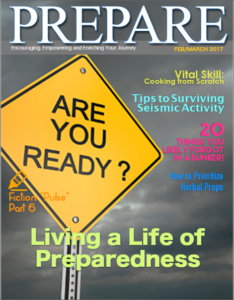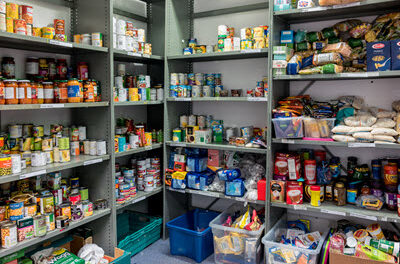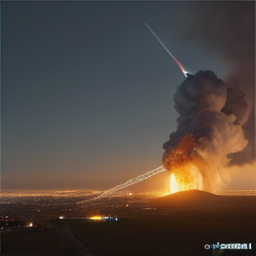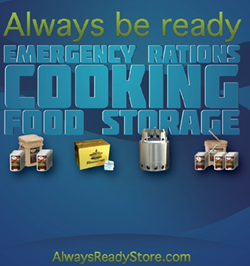When it comes to disaster preparedness, there is no such thing as being too cautious. In an unpredictable world, it is essential to equip ourselves with the knowledge and resources necessary to protect our lives and communities. From natural calamities like hurricanes and earthquakes to man-made emergencies such as fires and pandemics, being prepared can make all the difference between chaos and resilience.
 In this introductory piece, we will delve into the multifaceted realm of disaster preparedness, exploring the strategies, tools, and mindset required to navigate through the most challenging of circumstances. By the end, you will have a solid foundation upon which to build your own disaster preparedness plan, ensuring the safety and well-being of yourself and your loved ones.
In this introductory piece, we will delve into the multifaceted realm of disaster preparedness, exploring the strategies, tools, and mindset required to navigate through the most challenging of circumstances. By the end, you will have a solid foundation upon which to build your own disaster preparedness plan, ensuring the safety and well-being of yourself and your loved ones.
Throughout this exploration, we will touch upon various topics that encompass disaster preparedness. From creating emergency kits and evacuation plans to understanding the importance of communication and community resilience, we will leave no stone unturned. By adopting a proactive approach, we can mitigate the impact of disasters and enhance our ability to respond effectively when they strike.
This article aims to be a comprehensive resource, providing you with the information you need to take action and prepare for the unexpected. Whether you are a seasoned disaster preparedness enthusiast or just beginning your journey, there will be valuable insights and practical tips for everyone.
So, join us as we embark on this journey into the world of disaster preparedness. Together, we can empower ourselves and our communities to face any challenge that may come our way. Let’s ensure that when disaster strikes, we are not caught off guard but are instead prepared, resilient, and ready to weather the storm.
What Should I Include in a Disaster Preparedness Kit?
When it comes to disaster preparedness, having a well-stocked kit is essential. Whether you’re facing a natural disaster, power outage, or any other emergency situation, being prepared can make all the difference. But what exactly should you include in your disaster preparedness kit? Here are some key items to consider.
First and foremost, water is crucial. Make sure to have at least one gallon of water per person per day for a minimum of three days. This will ensure you have enough for drinking, cooking, and sanitation purposes. Non-perishable food items are also essential. Stock up on canned goods, dry goods, and snacks that have a long shelf life.
In addition to food and water, it’s important to have a supply of essential medications and a first aid kit. Make sure to include any prescription medications you or your family members may need, as well as over-the-counter medications for pain relief, allergies, and other common ailments. The first aid kit should include bandages, antiseptic wipes, gloves, and other basic medical supplies.
Other important items to include in your disaster preparedness kit are a flashlight with extra batteries, a battery-powered or hand-crank radio, a whistle to signal for help, and a multi-purpose tool. Additionally, it’s a good idea to have extra clothing and blankets, as well as personal hygiene items like toothbrushes, toothpaste, and toilet paper.
Lastly, don’t forget about important documents. Keep copies of your identification, insurance policies, and other important paperwork in a waterproof container. It’s also a good idea to have some cash on hand, as ATMs may not be accessible during a disaster.
By including these essential items in your disaster preparedness kit, you’ll be better equipped to handle any emergency situation that may arise. Remember to regularly check and update your kit to ensure everything is in working order and within expiration dates. Being prepared can provide peace of mind and potentially save lives. Stay safe!
How Can I Create an Emergency Communication Plan?
In times of disaster, having a well-thought-out emergency communication plan can mean the difference between life and death. When traditional communication channels fail, it is crucial to have alternative methods in place to ensure that you can stay connected with your loved ones and receive important updates. Here are some steps to help you create an effective emergency communication plan.
Firstly, establish a designated point of contact. This person should be someone who lives outside the immediate area and can act as a central hub for information. Make sure everyone in your family knows who this person is and has their contact information.
Next, select multiple communication methods. In a disaster, cell phone networks and internet connections may become unreliable. It is essential to have backup options such as landline phones, two-way radios, or satellite phones. Consider using social media platforms or messaging apps that work offline, as they can also be valuable tools for communication.
Additionally, create a list of emergency contacts. Include important phone numbers for local authorities, hospitals, and utility companies. Make sure everyone in your household has a copy of this list and knows where to find it.
Furthermore, establish a meeting place. Choose a location that is easily accessible and safe for everyone to gather in case you are separated during an emergency. Practice getting to this meeting place regularly, so it becomes familiar to all family members.
Lastly, stay informed. Stay tuned to local news stations, emergency alerts, and weather updates. Sign up for alerts from your local government or emergency management agency. Being aware of the situation and any evacuation orders is crucial for your safety.
Creating an emergency communication plan is essential for disaster preparedness. By following these steps, you can ensure that you and your loved ones stay connected and informed during times of crisis. Remember, preparation is key, so take the time to develop your plan today. Stay safe!
What Are the Essential Steps for Evacuation Preparedness?
Evacuation preparedness is crucial in ensuring the safety and well-being of individuals during times of disaster. Whether it’s a natural calamity like a hurricane or an unforeseen event such as a chemical spill, being prepared for an evacuation can make a significant difference in minimizing risks and ensuring a smooth transition to safety.
One of the essential steps for evacuation preparedness is to have an emergency kit readily available. This kit should include essential items such as non-perishable food, water, a first aid kit, flashlights, batteries, a portable radio, and any necessary medications. Having these supplies on hand will help sustain you and your family during the evacuation process.
Another crucial aspect of evacuation preparedness is having a communication plan in place. Identify a designated meeting point for your family members in case you get separated during the evacuation. It is also important to have a list of emergency contacts, including local authorities and relatives, readily available. Make sure everyone in your household is aware of the plan and knows how to reach these contacts.
Understanding evacuation routes and being familiar with local emergency shelters is also vital. Research and identify the primary evacuation routes in your area, and have maps readily available. Stay informed about the locations of emergency shelters and their procedures. This knowledge will help you make informed decisions during an evacuation.
Additionally, it is crucial to stay informed about the latest developments and updates during a disaster. Keep a battery-powered radio or a smartphone with emergency alert applications handy to receive real-time information and instructions from local authorities. Stay tuned to official channels and follow their guidance to ensure your safety.
In conclusion, being prepared for an evacuation is a critical aspect of disaster preparedness. By having an emergency kit, a communication plan, knowledge of evacuation routes, and staying informed, you can enhance your chances of a safe evacuation. Remember, preparedness is key when it comes to protecting yourself and your loved ones during times of crisis.
How Can I Safeguard Important Documents During a Disaster?
When disaster strikes, it’s crucial to have a plan in place to protect your important documents. Whether it’s a natural disaster like a hurricane or a man-made disaster such as a fire, safeguarding your documents can save you from a lot of stress and hassle in the aftermath. Here are some key steps you can take to ensure the safety of your important documents during a disaster.
First and foremost, it’s important to have digital copies of all your important documents. Scan your documents and store them securely on a cloud-based platform or an external hard drive. This will ensure that even if your physical copies are destroyed, you can still access your important information.
Additionally, it’s wise to keep physical copies of your documents in a waterproof and fireproof safe. This will provide an extra layer of protection in case of a disaster. Make sure to keep the safe in a location that is easily accessible and known to all family members.
Another important step is to create a grab-and-go bag that contains copies of your essential documents. This bag should include items such as passports, birth certificates, insurance policies, and any other documents that are difficult to replace. Keep this bag in a designated spot where it can be easily grabbed in the event of an emergency.
Furthermore, consider storing copies of your important documents with a trusted family member or friend who lives in a different location. This will ensure that even if your home is completely destroyed, you will still have access to your important information.
In conclusion, safeguarding your important documents during a disaster is crucial. By taking the necessary steps to create digital copies, store physical copies in a safe, and have a grab-and-go bag ready, you can ensure that your important information remains safe and accessible even in the face of adversity.
What Are the Different Types of Disasters to Prepare for?
 Disaster preparedness is crucial for ensuring the safety and well-being of individuals and communities in the face of various emergencies. While it is impossible to predict when and where a disaster will strike, being prepared for different types of disasters can significantly increase your chances of survival. Here, we will explore some of the most common types of disasters and how you can prepare for them.
Disaster preparedness is crucial for ensuring the safety and well-being of individuals and communities in the face of various emergencies. While it is impossible to predict when and where a disaster will strike, being prepared for different types of disasters can significantly increase your chances of survival. Here, we will explore some of the most common types of disasters and how you can prepare for them.
Natural disasters are perhaps the most well-known types of disasters. These include earthquakes, hurricanes, floods, wildfires, and tornadoes. To prepare for natural disasters, it is essential to have an emergency kit stocked with essentials such as food, water, medication, and flashlights. It is also crucial to have a plan in place for evacuation or seeking shelter in case of an emergency.
Another type of disaster to prepare for is a technological disaster. This can include events such as power outages, chemical spills, or nuclear accidents. In these situations, it is important to stay informed about potential risks in your area and have a plan for communication and evacuation if necessary.
Additionally, there are health-related disasters to consider, such as pandemics or disease outbreaks. In these cases, it is important to follow public health guidelines, maintain good hygiene practices, and have necessary medical supplies on hand.
Lastly, it is crucial to be prepared for human-caused disasters, such as terrorist attacks or civil unrest. In these situations, it is important to stay informed about potential threats and have a plan for sheltering in place or evacuating if necessary.
In conclusion, disaster preparedness is essential for everyone. By understanding the different types of disasters and taking proactive steps to prepare for them, you can significantly increase your chances of staying safe and protecting your loved ones in times of emergency. Stay informed, have a plan, and be ready to act when disaster strikes.
How Can I Prepare My Home for a Natural Disaster?
Natural disasters can strike at any time, leaving devastation in their wake. To protect your home and loved ones, it is crucial to be prepared. By taking proactive steps, you can minimize the impact of a natural disaster and ensure the safety of your family. Here are some essential tips to help you prepare your home for the unexpected:
First and foremost, create an emergency kit. This kit should include essential items such as non-perishable food, bottled water, flashlights, batteries, a first aid kit, and any necessary medications. Store this kit in a readily accessible location, making sure all family members know where it is kept.
Next, secure your home. Reinforce windows and doors to withstand high winds and flying debris. Consider installing storm shutters or impact-resistant glass to protect against hurricanes and tornadoes. Trim trees and shrubs near your home to prevent them from falling onto your property during a storm.
It is also crucial to develop an emergency communication plan. Designate a meeting point for your family in case you are separated during a disaster. Identify a trusted contact person who lives outside the affected area, as they may be easier to reach. Share important contact information with all family members.
Regularly maintain your home’s infrastructure. Inspect your roof for any signs of damage or weakness, and repair or replace as needed. Clean gutters and downspouts to ensure proper drainage during heavy rainfall. Check your home’s foundation for cracks, as these can lead to structural problems during earthquakes.
Lastly, stay informed. Monitor local news and weather reports to stay updated on potential threats. Sign up for emergency alerts and warnings in your area. Familiarize yourself with evacuation routes and shelter locations.
By following these steps, you can significantly increase the resilience of your home in the face of a natural disaster. Remember, preparedness is key to protecting your family and property. Stay vigilant and take action now to ensure a safer future.
What Are the Key Elements of a Family Emergency Plan?
When it comes to disaster preparedness, having a well-thought-out family emergency plan is crucial. Such a plan ensures that everyone in the family knows what to do and where to go in the event of a disaster. By incorporating key elements into your plan, you can increase your family’s safety and reduce the potential for panic and confusion.
1. Communication: Establish a reliable communication system that includes multiple methods such as phone calls, text messages, and social media. Ensure that everyone knows how to use these communication channels and has a designated meeting point in case communication is disrupted.
2. Emergency Contacts: Compile a list of emergency contacts, including local authorities, hospitals, and family members who live outside the immediate area. Make sure everyone in the family has a copy of this list and knows how to access it.
3. Evacuation Routes: Identify and map out evacuation routes for different scenarios, such as fires, floods, or earthquakes. Practice these routes regularly with your family members, so they become familiar with the process.
4. Shelter-in-Place: Determine safe areas within your home where family members can seek shelter during emergencies. These areas should be away from windows and have essential supplies like food, water, and a first aid kit.
5. Emergency Supplies: Assemble an emergency kit that includes essentials such as non-perishable food, water, medications, flashlights, batteries, and a battery-powered radio. Regularly check and update the supplies to ensure they are in good condition.
6. Special Considerations: Take into account the specific needs of family members, including infants, elderly individuals, or individuals with disabilities. Make sure you have necessary supplies and plans in place to accommodate these needs.
By incorporating these key elements into your family emergency plan, you can enhance your preparedness and ensure the safety of your loved ones. Remember to regularly review and update the plan as circumstances change. Stay informed about potential hazards in your area and educate your family members about the importance of disaster preparedness.
How Can I Stay Informed During a Disaster?
During a disaster, staying informed is crucial for your safety and well-being. Being aware of the latest updates and instructions can help you make informed decisions and take necessary actions. In this article, we will explore various ways to stay informed during a disaster, ensuring your preparedness and resilience.
One of the most reliable sources of information during a disaster is the emergency alert system. This system, often operated by local authorities, broadcasts important updates through various channels such as radio, television, and mobile alerts. Make sure you have a battery-powered radio and keep it tuned to emergency channels for the latest news.
In addition to the emergency alert system, it is essential to stay connected through multiple communication channels. Sign up for text alerts from local authorities and emergency management agencies. Follow their social media accounts and bookmark their websites for real-time updates. These platforms often provide valuable information on evacuation routes, shelter locations, and safety guidelines.
Another effective way to stay informed is by having a reliable weather radio. These radios are designed to receive National Weather Service alerts and provide continuous updates on severe weather conditions. Invest in a weather radio with a battery backup and keep it in a readily accessible place.
Furthermore, consider downloading relevant mobile applications that provide disaster-related information. Many apps offer real-time weather updates, emergency notifications, and even interactive maps to track disasters. Explore the app store or search online for apps specific to your location and disaster type.
 Remember, staying informed is an ongoing process. Continuously monitor the news and updates, especially during rapidly evolving situations. Keep your devices charged and have backup power sources available. By staying informed, you empower yourself to make informed decisions and protect yourself and your loved ones during a disaster.
Remember, staying informed is an ongoing process. Continuously monitor the news and updates, especially during rapidly evolving situations. Keep your devices charged and have backup power sources available. By staying informed, you empower yourself to make informed decisions and protect yourself and your loved ones during a disaster.
In conclusion, disaster preparedness is a critical aspect of ensuring the safety and well-being of ourselves and our loved ones. Throughout this post, we have covered a range of topics related to disaster preparedness, including what should be included in a disaster preparedness kit, how to create an emergency communication plan, essential steps for evacuation preparedness, safeguarding important documents during a disaster, different types of disasters to prepare for, preparing your home for a natural disaster, key elements of a family emergency plan, and staying informed during a disaster.
By understanding and implementing these key points, we can greatly increase our resilience and ability to respond effectively in times of crisis. Having a well-stocked disaster preparedness kit ensures that we have the necessary supplies and resources to sustain ourselves during an emergency. Creating an emergency communication plan allows us to stay connected with our loved ones and receive updates during a disaster. Being aware of the essential steps for evacuation preparedness ensures a smooth and efficient evacuation process. Safeguarding important documents protects our valuable information and helps us recover more easily after a disaster. Knowing the different types of disasters to prepare for allows us to tailor our preparedness efforts accordingly. Preparing our homes for natural disasters minimizes damage and enhances our safety. Developing a family emergency plan ensures that everyone in our household knows what to do in an emergency. Lastly, staying informed during a disaster through reliable sources of information keeps us updated and helps us make informed decisions.
Looking ahead, it is important to stay informed about any future developments or trends that may impact disaster preparedness. As technology advances, new tools and resources may become available to enhance our preparedness efforts. Additionally, the increasing frequency and intensity of certain types of disasters, such as extreme weather events, highlight the need for ongoing vigilance and preparedness.
Thank you for taking the time to read this post. We hope that the information provided has been helpful in guiding you towards a more prepared and resilient future. We encourage you to leave any comments or feedback, as your input is valuable in improving our content and ensuring that we continue to provide relevant and useful information on disaster preparedness. Stay safe, stay prepared!








